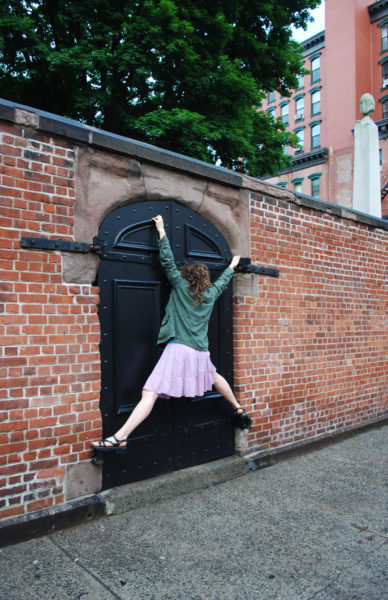La buena chaquetera y los cuatro caballos
(Solo Dancing Does Not Exist)*
La buena chaquetera y los cuatro caballos
(Solo Dancing Does Not Exist)*
A performance and movement interpretation experiment
* The Good Jacketer and the Four Horses, in English. “Chaquetera” (literally, “jacket-wearer”) is used in Spain to refer to people who change their connection to sports teams or political parties like jackets. “Solo dancing does not exist” is the first line of a text from choreographer and contact improvisation founder Steve Paxton.
–What is the relationship between gesture, movement and meaning? How do seemingly abstract movements acquire meaning through context, juxtaposition, or repetition, for example in the work of choreographer Pina Bausch? How can gestures or movements acquire multiple meanings for different viewers? In this performative movement and interpretation experiment, viewers will first watch a short, live gesture and movement-based performance and then have the opportunity to interpret, narrate, answer or ask questions of what they have just seen. In the ensuing dialogue, we will also examine the relationship between first, second and third person connection to the events or movements being experienced, interpreted, or communicated.
Concept and performance: Eryn Rosenthal, in first, second, and third person interaction with el público (the audience)
Text by Eryn Rosenthal and Federico García Lorca
“Making sense together”
Journées d’étude DIG: La Dynamique Interactionnelle du Geste
September 2016
Paris
.
More about La buena chaquetera:
La buena chaquetera y los cuatro caballos (Solo Dancing Does Not Exist)* reflects on current questions of Spanish democracy, participation and el público (the public, or the audience). In this work, el público and the concept of the public is present in multiple roles as witness, participant, and subject. Borrowing text from Federico García Lorca’s landmark surrealist play, El público, this performance experiment came out of a series of questions I had been investigating for a conference of neuroscientists and linguists. What is the relationship between gesture, movement and meaning? transmogrified into more political versions of itself. Over the course of creating the piece in Madrid in the midst of multiple corruption scandals, voter confusion and angst after Spain’s newly four-party system failed to form a government in two separate rounds of elections, the questions I had been previously researching for neuroscientists, on the relationship between movement and meaning (and, by extension, experimental dance and sense-making), began to incorporate larger social responses to choice-making (elections) and repetition, both in aesthetic composition as well as the composition/ decomposition of a government structure. What is the relationship between gesture, movement and meaning in this fraught context, amplified by voter exhaustion and disappointment? Lorca’s text provided a surrealist landscape of question and response that resonated with a scientific audience examining the complex human process of sense-making. The role of question-asking itself became a transformative act, speaking and dancing on multiple registers as I investigated collectively with the audience the process of meaning-making.
–Eryn Rosenthal
after many conversations, experiments, dinners, breakfasts, and rehearsals with friends and colleagues below;
Germany, Hungary, Spain and the US, summer 2016.
.
Mil gracias a Nieves Olcoz, Sergio Herrero Serradilla, Silvia Mira Illana, Ismael Martínez Martín, Alexandra Galindo, Eszter and Szofi Mirka Sarkadi, Geneviève Cron, Laci Sárkány, Hai Cohen, Tali Wertheim, Estér Forment, Marta Martínez de Aragón Martín, MariCrúz Planchuelo, Tía Carmen, Tiffany McKinney Gardner, Landon D. Reid, Alexandra Apostolides, Defne Erdur, João Fiadeiro, Malaika Sarco-Thomas, Asaf Bachrach, and Amy Chavasse.
Paxton, Steve. “Solo dancing” [1973], Contact Quarterly, vol. 2(3), 1977, p. 24.
Special shoutouts to Emma Bigé, whose text “Solo thinking does not exist” inspired parts of this work.
Solo thinking does not exist | Emma Bigé
La carte du Ponderàl | Emma Bigé
.
© Eryn Rosenthal, 2016. Please cite with link to this page.
